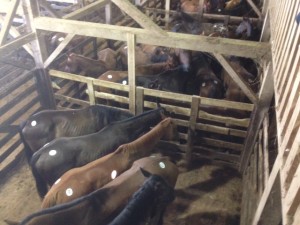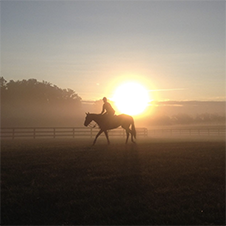
Broker Programs: It’s Complicated
Broker programs are perhaps one of the more controversial aspects of the horse slaughter system that we have in the United States.
A program is typically run by a rescue organization which has a relationship with a kill buyer. The rescue organization will promote the horses that have been acquired by the kill buyer, to help those horses find a home, before they would be shipped to slaughter if no home is discovered. This all occurs in a compressed timeframe.
This is the last chance for these horses. For that reason, many people will support these programs to try to help place these horses, either by supporting fundraisers, sharing the fundraisers, or offering homes.
Some of these horses were purchased by the kill buyer at a kill auction. Some were surrendered by owners who determined that they had no other option, due to a variety of circumstances. Some were culls from a variety of situations, some of which went directly to the kill buyer.
The kill buyer is the option of last resort.
So why the controversy ?
There are five broad reasons why some people consider the broker program bad for horses and the anti slaughter movement.
1. The number of horses slaughtered remains constant
A kill buyer, that enables a broker program, now has access to a new market for his horses. Thus, the kill buyer can purchase more horses, knowing that some will now be purchased through the broker program. The broker program is not reducing the number of horses that enter the slaughter pipeline, but is increasing the business opportunity for the kill buyer.
Because the broker program is not reducing the number of horses that the kill buyer is shipping to slaughter (that number is determined by the contract the kill buyer has with the slaughterhouse to which he is contracted), the broker program is essentially determining which horses go to slaughter. For each horse saved, another horse is swapped into his place.
2. Emotional buy
The broker program typically operates in a compressed timeframe with a certain outcome. The kill buyer purchases the bulk of his horses at a kill auction (New Holland, PA or Sugarcreek, OH for example) and will ship those horses to a slaughterhouse, or the slaughterhouse’s feedlot, a week or so later. It is within that timeframe that the broker program needs to take pictures, and promote the horses through social media and other outlets.
The sense of urgency is real, the images are real, the “kill truck is coming” is a popular refrain. This creates a situation of drama, that inspires people to do things that they might not do under ordinary circumstances.
It also deflects money and effort from other types of rescue programs, and the broader horse slaughter issue.
3. The Price is High
Oftentimes the horses are surrendered to the kill buyer, or purchased very cheaply at the auction. Because the community is trying to “rescue” these horses, there is a sense that they should be able to purchase the horses at close to what the kill buyer pays. In some instances this will happen, if you have a relationship with the kill buyer, and make an offer to him at the auction, after the sale of a horse. At that point the kill buyer can simply purchase another horse to replace the one he has bought.
Once in the broker program, this is no longer the case. The kill buyer’s main customer at this point is the slaughterhouse, so it is that price point, the price that the kill buyer can earn at the plant, that should be used to compare the prices offered by the broker program. This may be 50-100% over the purchase price at the kill auction for example.
Added to that are costs associated with the broker program. It takes time and work to make these horses available online, that time and work also needs to be rewarded.
4. Selective Access
The method of deciding which horses are available through the broker program also creates controversy. It is not always all the horses that the kill buyer has in stock. Why? The kill buyer has horse dealers with whom he works. Sometimes those dealers do not want to be exposed (someone hussling racehorses from the local racetrack for example) so the horses that that dealer brings to the kill buyer will not be part of the program.
Because the broker is typically the only “rescue” with access to the kill buyer’s pens, and understands which horses can be made available and which cannot, many consider that they are simply complicit in the entire slaughter system.
5. Working with a Kill Buyer
Can someone really be considered a rescue, if all they do is offer a broker program and work directly with the kill buyer? Some argue no, some of course argue that absolutely they can.
The relationship with the kill buyer is controversial, especially if there is a lack of transparency in terms of how that relationship works. Broker programs that have been controversial in the past include CBER (Washington State) and AC4H (Pennsylvania).
In Conclusion…
This is a controversial aspect of the horse slaughter system, of that there is no doubt. Broker programs have done some great things, especially for the individual horses which have been saved, but there are always consequences to these transactions.
If you think I missed a point, or wanted to share your thoughts, please use the comments.
To learn more about the horse slaughter issue, you can explore my three part video series, Horses: Sports, Culture, and Slaughter.

You have left out the most important piece… Broker programs often do NOT market the horses that will go to slaughter. Instead, the kill buyer purchases lame, old, sick or otherwise unhealthy animals to market in their program. These horses are often never intended to be shipped, but rather they are marketed to all of the bleeding hearts through these broker programs… They are purchased for next to nothing and sold way above the price per pound that would be obtained at the slaughterhouse. The fat healthy horses are often never seen in the broker programs. in this way the kill buyer is now able to have a market for horses he is unable to ship. THIS his where the controversy comes from! We always hear how the slaughter truck is coming and we need to save the horses! The only thing is, no matter how many of these lame, old and tired animals we buy the slaughter truck will still come for a fat healthy horse that we never even saw.
The problem I have with broker programs is that the homes the horses are going to aren’t screened. We have a very difficult time placing horses because there are few good homes out there. Take for example, the Copiah County horses in MS. Large herd of horses found neglected in kill buyers feed lot, lots of media coverage and all of a sudden, there are homes for 90+ horses. We took 12 horses to our rescue, 2 were fostered so that’s 14 horses. At the time we had people begging to help. Even had a rescue group who was taking two breed specific horses, there were two blind ones that we said we couldn’t take unless we knew they had a home. We took the horses on December 18, 2014. Long story short, 7 months later, guess how many we still have! ELEVEN!!! Why? People quickly lost interest during the 30 day quarantine period, the rescue’s foster home lost her property, the lady who was going to take the two blind horses was in over her head with her donkeys. That’s very typical. We could have collected the $14,000 raised and given the horses away after the 30 days and pocketed a lot of the money. Instead, we are in need of raising money to continue to provide care and training until the right home comes along. How many horses saved from a broker program really go to good homes? I wonder how many end up back in the slaughter pipeline?